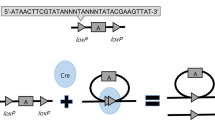Abstract
Telogen effluvium is a common type of hair loss. Although the morphological changes associated with telogen effluvium have been well characterized, the underlying molecular mechanisms remain unknown, and no animal models have been developed. We report here that inducible transgenic mice expressing high levels of the transcription factor, tTA (tetracycline transactivator), plus a reporter luciferase gene, show a reversible hair loss phenotype. Skin of these mice exhibits an increase in the number of hair follicles at the telogen phase, but a decreased number of follicles at the anagen phase. These changes resemble skin pathology seen in patients with telogen effluvium, which suggests that the inducible transgenic mice may be useful as a model for this disorder. Moreover, since overexpression of several other transgenes failed to cause skin pathology, the present findings also indicate types of molecular abnormalities that may cause reversible hair loss.
Similar content being viewed by others
References
Baker AJ, Redfern CH, Harwood MD, Simpson PC and Conklin BR (2001) Abnormal contraction caused by expression of G(i)-coupled receptor in transgenic model of dilated cardiomyopathy. Am J Physiol Heart Circ Physiol 280: H1653–H1659.
Botchkarev VA, Komarova EA, Siebenhaar F, Botchkareva NV, Sharov AA, Komarov PG et al. (2001). p53 Involvement in the control of murine hair follicle regression. Am J Pathol 158: 1913–1919.
Chen J, Kelz MB, Zeng G, Sakai N, Steffen C, Shockett PE et al. (1998). Transgenic animals with inducible, targeted gene expression in brain. Mol Pharmacol 54: 495–503.
Gossen M and Bujard H (1992). Tight control of gene expression in mammalian cells by tetracycline-responsive promoters. Proc Natl Acad Sci USA 89: 5547–5551.
Green EA, Wong FS, Eshima K, Mora C and Flavell RA (2000). Neonatal tumor necrosis factor alpha promotes diabetes in nonobese diabetic mice by CD154-independent antigen presentation to CD8( +) T cells. J Exp Med 191: 225–238.
Hasan MT, Schonig K, Berger S, Graewe W and Bujard H (2001). Long-term, noninvasive imaging of regulated gene expression in living mice. Genesis 29: 116–122.
Headington JT (1993). Telogen effluvium. New concepts and review. Arch Dermatol 129: 356–363.
Hope BT, Kelz MB, Duman RS and Nestler EJ (1994). Chronic electroconvulsive seizure (ECS) treatment results in expression of a long-lasting AP-1 complex in brain with altered composition and characteristics. J Neurosci 14: 4318–4328.
Kelz MB, Chen J, Carlezon Jr WA, Whisler K, Gilden L, Beckmann AM et al. (1999). Expression of the transcription factor delta-FosB in the brain controls sensitivity to cocaine. Nature 401: 272–276.
Kelz MB, Kuszak JR, Yang YQ, Ma WC, Steffen C, Al-Ghoul K et al. (2000). ΔFosB induced cataract. Invest Ophthalmol Vis Sci 41: 3523–3538.
Kligman A (1961). Pathologic dynamics of human hair loss. Arch Dermatol 83: 175–198.
Malleret G, Haditsch U, Genoux D, Jones MW, Bliss TV, Vanhoose AM et al. (2001). Inducible and reversible enhancement of learning, memory, and long-term potentiation by genetic inhibition of calcineurin. Cell 104: 675–686.
Rebora A (1997). Telogen effluvium. Dermatology 195: 209–212.
Sabatakos G, Sims NA, Chen J, Aoki K, Kelz MB, Amling M et al. (2000). Overexpression of DeltaFosB transcription factor(s) increases bone formation and inhibits adipogenesis. Nat Med 6: 985–990.
Shockett P, Difilippantonio M, Hellman N and Schatz DG (1995). A modified tetracycline-regulated system provides autoregulatory, inducible gene expression in cultured cells and transgenic mice. Proc Natl Acad Sci USA 92: 6522–6526.
Shockett PE and Schatz DG (1996). Diverse strategies for tetracycline-regulated inducible gene expression. Proc Natl Acad Sci USA 93: 5173–5176.
Sonoda T, Asada Y, Kurata S and Takayasu S (1999). The mRNA for protease nexin-1 is expressed in human dermal papilla cells and its level is affected by androgen. J Invest Dermatol 113: 308–313.
Tanaka M, Inase N, Miyake S and Yoshizawa Y (2001). Neuron specific enolase promoter for suicide gene therapy in small cell lung carcinoma. Anticancer Res 21: 291–294.
Tosti A, Piraccini BM and van Neste DJ (2001). Telogen effluvium after allergic contact dermatitis of the scalp. Arch Dermatol 137: 187–190.
Whiting DA (1996a). Chronic telogen effluvium. Dermatol Clin 14: 723–731.
Whiting DA (1996b). Chronic telogen effluvium: increased scalp hair shedding in middle-aged women. J Am Acad Dermatol 35: 899–906.
Yamamoto A, Lucas JJ and Hen R (2000). Reversal of neuro-pathology and motor dysfunction in a conditional model of Huntington's disease. Cell 101: 57–66.
Author information
Authors and Affiliations
Rights and permissions
About this article
Cite this article
Chen, J., Kelz, M.B., Zeng, G. et al. Inducible, reversible hair loss in transgenic mice. Transgenic Res 11, 241–247 (2002). https://doi.org/10.1023/A:1015619604318
Issue Date:
DOI: https://doi.org/10.1023/A:1015619604318




